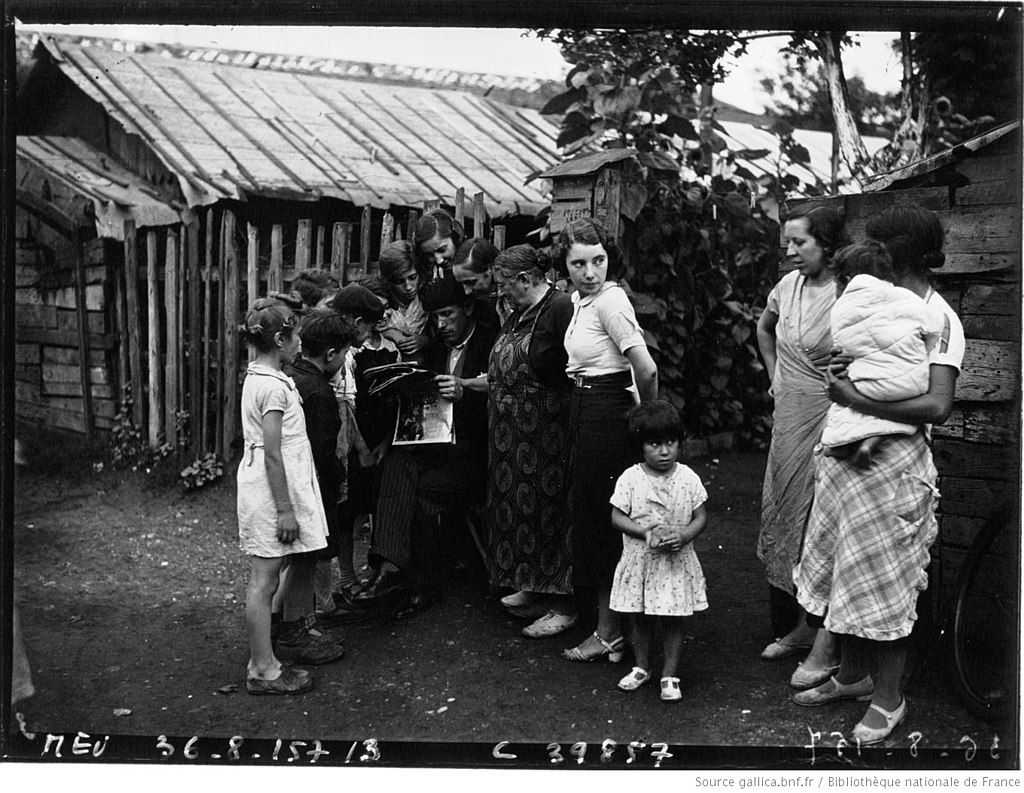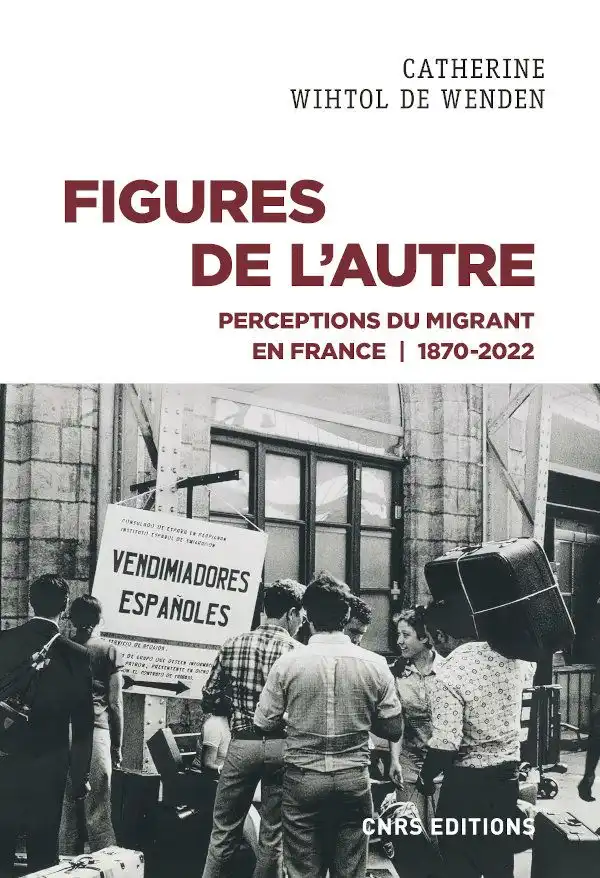Home>How is the Other perceived?

15.07.2022
How is the Other perceived?
Interview with Catherine Wihtol de Wenden
In her book Figures de l'Autre. Perceptions du migrant en France, 1870-2022, published in July 2022 by CNRS Éditions, Catherine Wihtol de Wenden offers what she describes as a "second-degree" exploration of immigration in France through the ways in which this social issue is perceived and how it is conveyed in images. She shows how the collective memory of the immigrant Other has been built up over the years, since 1870. Catherine Wihtol de Wenden answers our questions.
The book covers a period from 1870 to 2022. Why did you start the study in 1870? What events characterise this year and how does the issue of migration come into play?
CNRS Éditions invited me a long time ago to write a book on how immigration is represented, while I was working on different aspects of this research subject. I chose to treat the issue as a research itinerary, through four decades of work. I chose to start in 1870 because there are hardly any texts on the “immigrant Other” for this period, except for the most famous figures in French history, such as the queens and their entourages or those who played a notable role before the 1870s (Catherine de Medicis, Concino Concini, Mazarin, Marie-Antoinette, John Law, Thomas Paine, Anacharsis von Clootz). The collective rather than individual figure of the Other that emerged in 1870 was that of the Prussian, ascribed with all the attributes of the “barbarian”, an abstract construct based on ethnic and linguistic belonging to the Germanic world, as opposed to the French figure of Marianne , who represented the non-ethnicised republican values of the social contract and the ideals of the French Revolution.
This period also marks the beginnings of labour immigration to the mines of the North and Lorraine (Émile Zola alludes to the Belgians in Germinal), to the salt mines of the South (let us remember the massacre of the Italians in 1893), and to large urban construction sites (the Goutte d'Or district in Paris emerged during the construction of the Gare du Nord and Gare de l'Est railway stations, which began in the middle of the nineteenth century), or in the context of nascent industrialisation. Images of the “immigrant” Other multiplied, even though the distinction between nationals and foreigners was still in its early stages, since rights were not yet strongly differentiated between the two and people from the French provinces were sometimes saddled with the same stereotypes (Auvergnats, Bretons) when they arrived in Paris.
The end of the nineteenth century was characterised by the beginning of intervention by the public authorities, who were anxious to "make French people out of foreigners" by widening access to nationality (based on the jus soli and jus sanguinus since 1889) because of the Germans' feared demographic growth and the decline of the French population in the event of conflict.
You suggest four periods for this study, can you say a few words about them? Did each period produce a figure of the Other?
The first period extends from 1870 to the First World War: France is the only European country to be a country of immigration, its neighbours being countries of emigration not only to France, but also to the Americas or Australia. The French migrated rarely, but the colonial phenomenon somewhat masked their movements towards Africa or Asia.
After the arrival of refugees from the First World War (Armenians, Russians, "Levantines" from the Ottoman Empire), the interwar period was marked by the rise of virulent xenophobia and anti-Semitism, which was widely reported in the press and public opinion. This was against a backdrop of economic crisis in the 1930s, the closure of immigration in 1932, and the reluctant reception of refugees from authoritarian regimes (Italians, Germans, Spaniards), before some of them took part in resistance movements.

The period 1945-1975 saw the rejection of the Other fade away, against a backdrop of economic prosperity and labour needs, at a time when the world of labour and trade unions was seeking to forge links with foreign workers in the name of the unity of the working class against discrimination, and when the question of migration was highly depoliticised. In 1974, the oil crisis and the conflict between the French and Algerians led to Algeria stopping its immigration and France suspending the immigration of salaried workers in 1974, after the election of Valéry Giscard d'Estaing. This is when an immigration and integration policy began to appear. However, no law was passed on the subject between 1945 and 1980. This was the so-called "infra-law", which was dealt with through phone calls, telexes, and informal meetings, without any legal basis for the defence of foreigners' rights.
From the municipal elections of 1983 onwards, the Front National gained political representation, and the politicisation of the issue of immigration continued to multiply the negative images of the phenomenon on subjects such as competition in the labour market, radical Islamism, and prayers in the public space. At the same time, non-European immigrants began to settle permanently in French territory, with return trips to their home countries no longer being possible due to the closure of the European Union's external borders. A security arsenal developed in Brussels, which accelerated the militarised vision of the subject of the immigrant and strongly distinguished Europeans from non-Europeans with increasingly dissuasive and repressive control instruments (Dublin agreements on asylum, visas, fingerprinting of asylum seekers, Frontex). The fall of the Iron Curtain added a new element to the theme of new competitors, such as the emblematic "Polish plumber", while terrorism, from 1995 onwards, gave credence to the supporters of the unbridgeable divide with Islam.
The last two decades have seen the globalisation of the phenomenon of migration, and a confrontation between the advocates of globalisation and cosmopolitanism and those who are turning back to their "roots", the "native French" and those who are not—in a country where 30% of the population has a foreign ancestor—against a backdrop of rising European populism. Numerous contradictions emerge: labour needs dictated by economic liberalism despite the loss of influence of employers over the last 30 years, a vision of security, an ethic of solidarity with refugees, and the offences of solidarity inflicted on those who welcome them. Contrasting images of the figure of the Other today oppose the treatment of Ukrainians and refugees from the Middle East or Africa, the latter being suspected of being “asylum cheats”.
The stereotypes have always been the same throughout the different periods, whatever the successive waves of migration: violence, communitarianism, lack of integration, conservatism of lifestyles. Today, there is a confusion of terms between the migrant, who is undesirable, and the refugee, who cannot be totally rejected. There is also a hierarchy between the two, depending on their origins. Certain boundaries in collective representations have become more pronounced, such as the one between Europeans and non-Europeans, Muslims and Christians, but they are largely constructed and linked above all to the migratory regimes that are at the origin of undocumented migrants, unaccompanied minors, and rejected asylum seekers, rather than to the intrinsic characteristics of the migrants themselves, who are often lumped together and not considered individually in their diversity.
You have conceived this book as a research itinerary over the course of 40 years of work on immigration, and you take a certain distance from this Other, which has been your object of research over these four decades. In this book, you focus on images, on the imaginary, based not only on your numerous research projects, on the rich literature on this theme, but also on filmography. Can you tell us more about this?
Examining images and collective representations required me to take a different look at what I had studied, looking at representations of immigration as they appeared in the press, films, novels, televised political debates, public policies or by referring to the work of historians on images of the Other. No study had ever been carried out on this topic looking at such a large time span and by mixing such varied sources of data relating to the constructions of the Other: war of numbers, categorisations, preconceptions, national and European public policies, emblematic figures of the foreigner, the specialised worker, then the Muslim, the young people living in the suburbs, the terrorist, the refugee, the undocumented migrant, all of which are the objects of successive constructions and deconstructions in the course of the forms of depoliticisation and politicisation of the Other.
Different levels of analysis are questioned as shaping the framework, as well as the monographs collected in the survey work. Reconstructions also exist in this landscape, against the negative images: inclusive citizenship, the fight against discrimination, the construction of a memory of living together through the use of museums, because stereotypes are persistent before accepting that the Other resembles us in societies that are becoming increasingly cosmopolitan. The discrepancy between migration policies, which are often presented as a response to crises and are based on opinion polls, and the fear of those who are afraid often leads to the failure of these policies and to a headlong rush into the security arsenal. The figures of the Other reflect this state of affairs.
Do the aesthetics of the migrant play a role? How do the images conveyed in our societies maintain a culture of fear of otherness, a source of rejection of those who embody immigration?
Migration policies that are intended to be dissuasive end up creating the figure of the undesirable, by denying migrants access to housing, to the labour market, to rights, in a never-ending war on migrants, as can be seen in the Mediterranean. They have the opposite effect to that desired, because they do not dissuade the most determined to change their lives. They spread a negative image of young people who do not work, who wander in urban areas, who have come because of the appeal of Western societies. Today, the « push factor », that pushes people to leave their homes, is more powerful than the « pull factor ». Unlike in the past, what leads people to leave their country is linked to political crises, endemic unemployment, corruption of the leaders, and ambient instability. And those who leave are more educated, more qualified, and more urban than in the past, which no longer corresponds to the image of the rural and illiterate migrant, who left to earn money and send it back home with a view to returning. But representations still lag behind the very rapid evolution of the multiple transformations of the Other.
A study of institutional discrimination shows that representations of the Other can also lead to the intervention of public actors, where this Other is contextualised in relation to a territory, to a real or supposed group of belonging, in a determinism that is sometimes implacable: a study of young people of immigrant origin in the French army shows that they have difficulty being recognised by their fellow soldiers as French like the others, because they are suspected of being part of assigned communities...
Interview by Miriam Périer, CERI.
Cover image caption: Les réfugiés espagnols dans la région parisienne, 1934 (credits: Agence de presse Meurisse)
Follow us
Contact us
Media Contact
Coralie Meyer
Phone : +33 (0)1 58 71 70 85
coralie.meyer@sciencespo.fr
Corinne Deloy
Phone : +33 (0)1 58 71 70 68
corinne.deloy@sciencespo.fr
